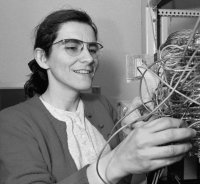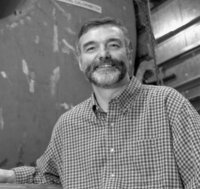 |
|
Users: Fermilab Wouldn't Be the Same Without Them by Mike Perricone
They’re called “users,” but Fermilab’s guest and visiting scientists are woven inextricably into the fabric of the laboratory.
In fact, users often represent the fabric of the laboratory as distinctively as many full-time and long-term researchers, and their official description comes as something of a surprise. They might be guests, but Fermilab has been their home for a long time.
Just a couple of examples: Harry Weerts of DZero and Vaia Papadimitriou of CDF, both longstanding integral members of the large detector experiments. They also represent the lab’s widespread international base, with its links to nearly 1,000 international researchers from 113 institutions in 29 countries, and to more than 1,500 researchers from 101 institutions in 31 states across America. But even these categorical distinctions can become a bit indistinct.
For Papadimitriou, it was just the beginning of a dedicated and energetic level of public contact. She has been teaching at Texas Tech since 1994, continuing her work at CDF, and extending the outreach activities that the Lederman Fellowship originally encouraged. She led several public tours of the 5,000-ton CDF detector before it was rolled into the collision hall to begin Collider Run II of the Tevatron in March 2001.
“These have all been very rewarding experiences for me,” Papadimitriou said. “I have seen families with two or three kids, and sometimes carrying babies, growing excited with what they saw, asking questions and coming again to the next tour. Visitors sometimes stayed for three hours, asking us detailed questions about our work.”
Papadimitriou’s courses at Texas Tech range from nuclear and particle physics and electromagnetism for undergraduate and graduate physics majors, to general physics for pre-med students. She was on sabbatical at Fermilab during the Fall semester with two students under her wing. Contact with students and with the public is as important to her as research.
“The young people who come here to visit will perhaps encourage their own kids to study science,” she said. “They will know more about it, and hopefully they will not put physics in a castle on top of a mountain that is only for ‘the few and the brave.’ Hopefully, physics will be more approachable for them. Physics is exciting, and it is fun to share and communicate that excitement.”
“Meetings, meetings and more meetings,” Weerts said. “We rely very much on email and the Web. Also very important are our three or four collaboration meetings during the year, as well as our annual workshop. We also organize many smaller, very focused topical workshops, which typically take place at participating institutions instead of here at Fermilab. One advantage we have is that we are one of the first experiments to really ship our data all across the globe. The other main ingredient is that collaborators regularly visit Fermilab from all over the world.”
Weerts, originally from The Netherlands, counts as a user from the state of Michigan. He arrived at Fermilab as a postdoc in 1981 on experiment E594, a neutrino fixed target experiment. He joined the faculty at Michigan State University in 1983, and has been classified as a user since then. As cospokesperson at DZero since 1996, he has shared in management responsibilities including the extensive upgrade effort readying the detector for Collider Run II of the Tevatron. But it’s a little different being a manager with few actual “employees,” with work often done by researchers representing individual institutions and projects, sometimes having limited time at the lab, and conducting some work at home institutions.
“Most of the time it’s exhilarating, because you work with colleagues from all around the globe,” Weerts said. “Sometimes it’s frustrating, because you have a clear goal and mandate, but cannot tell anybody directly what to do. But somehow, this system works, and most of the time my collaborators are willing to accept guidance—though after discussion. Basically it works on the basis of the respect that people have for all the individual managers, at every level.”
Also at every level, encountering an array of languages represents the norm at Fermilab, a multinational hub in the traditionally internationalist field of high-energy physics. While users from the U.S. (1,521) outnumber foreign users (983) in 2002, the number of foreign institutions represented at Fermilab (113) actually outnumbers domestic institutions (101). The margin is fairly consistent: the 2001 count showed 100 U.S. institutions and 104 international institutions, but the breakdown in 2000 was 101 domestic and 116 international institutions.
Representing this global congregation is Fermilab’s Users Executive Committee, with a chairman elected each year and members (drawn from both the users’ community and Fermilab) serving overlapping terms of varying lengths.
“I would describe the environment as normal human interaction, but with a clear flavor of the various countries from which people come,” said UEC member Rick St. Denis of CDF and Glasgow University in Scotland, a user since 1984. “To me, it is not unlike a standard American family wedding where the Irish, or Polish, or Italian families try to plan things and everyone is related to people everywhere of all origins.”
The UEC accepts challenges that range from helping with visa problems, to improving onsite transportation, to obtaining new office space for both detector collaborations, to organizing educational and outreach efforts, to staffing the weekly Ask-A-Scientist sessions at the Lederman Science Education Center—and, of course, to insuring the best physics for users.
“In Run II, we hope for a watershed of physics and continued cracking of the Standard Model along its seams,” said St. Denis. “I hope that as we investigate the various physics topics we can find inconsistencies. This may well be enshrined in a search for the Higgs.”
“The Users’ Meeting is a time for the whole lab to get together and learn what everyone else has been up to,” said UEC chair Benn Tannenbaum of CDF and the University of California at Los Angeles.
“We will have speakers from all experiments on site covering as many of the different research areas as possible,” added Tannenbaum, who came to Fermilab as a summer student in 1989 and joined CDF as a graduate student in 1992. “We also will have speakers from the Department of Energy and the National Science Foundation discussing funding priorities. We will have a State of the Lab talk from Fermilab Director Michael Witherell, and we also hope to have a State of the Lab talk from SLAC Director Jonathan Dorfan. The URA will be there, to discuss their perspectives on the future and to present the annual URA thesis award.”
The UEC also organizes an annual spring visit to Washington, DC with users visiting members of Congress and their staffs to familiarize them with science education and research efforts under way in their home districts, and with science ties around the world.
“Science is an international effort,” Tannenbaum said, “and the physical sciences are important to everyone.”
From Massachusetts to Hawaii, from Russia to Argentina, from Canada to China, Fermilab users bring that point home.
|
 Papadimitriou, originally from Greece, counts as a user from Texas. She came to Fermilab in 1985 as a graduate student on experiment E731 (CP Violation, completed 1988) by way of the University of Chicago. In 1990, she was named the lab’s first Leon M. Lederman Fellow, awarded for a first postdoctoral appointment in experimental physics at Fermilab. She worked at CDF through 1994 on the fellowship. And in keeping with Lederman’s commitment to the teaching of physics, fellows participate in Saturday Morning Physics and other educational programs.
Papadimitriou, originally from Greece, counts as a user from Texas. She came to Fermilab in 1985 as a graduate student on experiment E731 (CP Violation, completed 1988) by way of the University of Chicago. In 1990, she was named the lab’s first Leon M. Lederman Fellow, awarded for a first postdoctoral appointment in experimental physics at Fermilab. She worked at CDF through 1994 on the fellowship. And in keeping with Lederman’s commitment to the teaching of physics, fellows participate in Saturday Morning Physics and other educational programs.
 Weerts has a different communication challenge: as cospokesperson at DZero, he shares the charge of coordinating the efforts of more than 500 researchers from 73 institutions, covering a rainbow of languages and cultures, in building and operating the detector and ultimately producing physics results. How is it done?
Weerts has a different communication challenge: as cospokesperson at DZero, he shares the charge of coordinating the efforts of more than 500 researchers from 73 institutions, covering a rainbow of languages and cultures, in building and operating the detector and ultimately producing physics results. How is it done?
 More than 600 Fermilab users are classified as students (nearly 400 from the U.S.), and education is a UEC priority. Graduate students can often be found leading guided tours of the lab, or dashing off to make physics presentations at schools throughout the surrounding area. The UEC also organized a mentoring get-together last year for young scientists to talk with experienced scientists about their work and their career. There’s also the “general assembly,” the Users Annual Meeting held each summer at Fermilab, truly a lab-wide event.
More than 600 Fermilab users are classified as students (nearly 400 from the U.S.), and education is a UEC priority. Graduate students can often be found leading guided tours of the lab, or dashing off to make physics presentations at schools throughout the surrounding area. The UEC also organized a mentoring get-together last year for young scientists to talk with experienced scientists about their work and their career. There’s also the “general assembly,” the Users Annual Meeting held each summer at Fermilab, truly a lab-wide event.